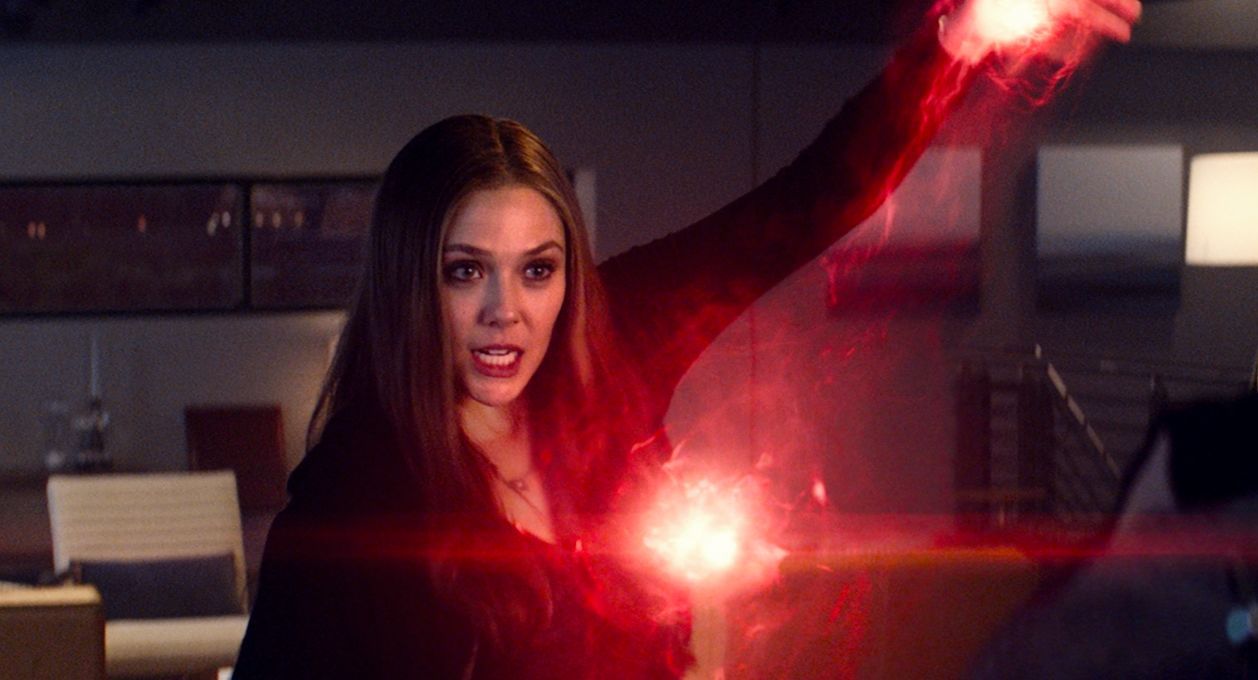This guest post written by Maddie Webb appears as part of our theme week on Superheroines. | Mild spoilers for Captain America: Civil War.
There is a lot to dissect in Captain America: Civil War, which is what makes it so compelling to watch. It’s a film overflowing with political allegory and highly anticipated character introductions, building to perhaps the most emotional climax to a superhero film ever seen. It is therefore understandable that most of the reviews and buzz around the film don’t seem too interested in the small role Elizabeth Olsen’s Scarlet Witch plays in the greater plot machinations of the superhero showdown. This is kind of a shame because her character arc gives me hope for the other women superheroes in the Marvel Cinematic Universe (MCU), whose treatment of their all too few female characters in the past has been checkered at best.
Introduced in Avengers: Age of Ultron alongside her brother Quicksilver, Scarlet Witch (Wanda Maximoff)’s entrance into the MCU seemed to be more of a result of Marvel’s endless pissing contest with Fox rather than anyone actually wanting to do something interesting with the character. Sure, she gets to mess with the Avengers’ minds and rips out Ultron’s mechanical heart, but she never feels like a three-dimensional human. Instead, she exists more as a tool to move pieces into place and create conflict within the team. Though not at quite the same level as the treatment Black Widow gets in the film, which some people saw as tantamount to character assassination, Wanda’s introduction is, like the rest of the film, a bit underwhelming.
Imagine my surprise when leaving Civil War, the first thing I wanted to do was read House of M so I could fall in love with Scarlet Witch’s comic counterpart as well as her movie form. In Civil War, Scarlet Witch doesn’t just drive the plot forward but she’s allowed to exist as a fully formed young woman, all without undermining the fact that she is the most powerful character that has been introduced into the MCU so far. That is so exciting to me it’s kind of ridiculous. It’s also no small feat considering incredible unbridled power in the hands of a young woman is something that pop culture often fails to portray with any nuance. As film critic Bob Chipman commented, in traditional storytelling, “Male characters that get power can be destructive if they abuse it, but female characters with power will be destructive period.” This is not the case here.
In the opening of Civil War, an incident in Lagos results in major civilian casualties due, at least in part, to Wanda’s actions. Although, Captain America himself admits that he, as their leader is responsible, the wider world decides that Scarlet Witch is the one who cannot be trusted, perhaps since she isn’t the all-American hero Steve Rogers is. For a short time, she is public enemy number one and she reacts in a deeply emotional and human way, questioning her own actions and purpose as an Avenger. One of the worst tropes of modern action screenwriting is the “strong woman,” the omni-competent badass who on the surface is empowered but realistically is devoid of any complexity or characterization. Here Wanda is the antithesis of that, a young woman who is at once undeniably strong but emotionally complex, perhaps even a little fragile. It may be a small plot point in the broad scheme of the film but it’s a moment of subtle and important character development. Rather than breaking down entirely or being completely without remorse, the film presents Wanda’s guilt as both understandable and authentic, but most importantly, something that strengthens her as the plot progresses.
Having a superhero grapple with the right use of their power is hardly a new theme and it’s central to the broader narrative of Civil War. But allowing a female superhero to tackle the same dilemma on a deeply personal level feels quietly subversive. Wanda’s powers aren’t a curse and haven’t corrupted her, like with so many female characters, but she also learns that as her abilities grow so will the consequences of her actions. “With great power comes great responsibility,” is a well-worn superhero trope but it’s normally one reserved for men.
Even the traditional and potentially problematic elements of Wanda’s relationships with the other characters are resolved in a satisfying way. Her relationship with Vision is sweet, genuine, and has none of the clumsy melodrama of Black Widow and Bruce Banner’s forced romance (despite how I sound, I don’t actually hate Age of Ultron). Their relationship is based on mutual experiences of feeling like the “other” in a world that doesn’t quite know how to react to them and the burden possessing a greater power they don’t quite understand. Furthermore, when it becomes clear that Vision is willing to keep Wanda in the Avengers compound against her will, in one of the coolest moments in the film, Wanda makes it abundantly clear that even Vision isn’t strong enough to stop her from doing what she wants.
In fact, Tony Stark and Vision not trusting Wanda is a huge part of why she chooses Team Cap; she’s strong enough to leave a team when she knows she’s not respected. In one of my favorite interactions in the film, Wanda accuses Tony of trying to lock her in her room and when he tells her it was for her own good, she responds by dropping a car park on his head. While her surrogate father figures, Captain American and Hawkeye, refer to her as just a kid, Wanda’s heroic displays in the now legendary airport scene show that she can handle herself and her powers just fine.
Maybe this is what really gets to the heart of why I’m so jazzed about Scarlet Witch in this movie and the potential of Captain Marvel, the Wasp and the future women in the MCU (personally, I’m praying for Squirrel Girl). With the right script and actress — Elizabeth Olsen really is stellar here — Civil War proves that women superheroes can be inhumanly powerful without being reduced to a boringly infallible female badass caricature. The conclusion of Wanda’s mini character arc consists of learning and empowerment. As Vision warns her, that choosing Captain America’s side will mean people will never stop fearing her power, she replies, “I cannot control their fear, only my own.” Forget Team Cap or Team Iron Man, that sounds like a woman whose team I want to be on.
See also at Bitch Flicks: Scarlet Witch and Kitty Pryde: Erased Jewish Superheroines; Do Black Widow and Scarlet Witch Bring Female Power to ‘Avengers: Age of Ultron’?
Maddie Webb is a student currently studying Biology in London. If she doesn’t end up becoming a mad scientist, her goal is to write about science and the ladies kicking ass in STEM fields.







